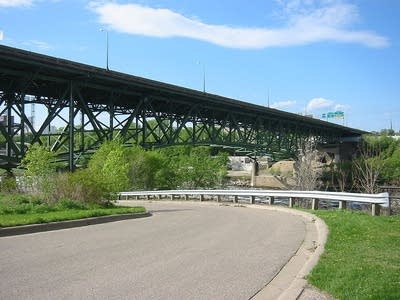Advancements help speed bridge rebuild

The collapsed I-35W bridge carried a daily traffic count of 140,000, supported eight lanes of traffic, and ran about 1,900 feet long, its largest span measuring nearly 460 feet.
The Minnesota Department of Transportation wants to replace the fallen bridge with one carrying even more lanes -- another lane per side. Some of them could be used for mass transit. The agency also requires that the new bridge safely convey drivers from one side of the river to the other for at least 100 years.
This was much more difficult 40 years ago.
How in the world do bridge designers and engineers work out such huge expectations of scale, duration, and safety in such a short period of time? For starters, they get a lot of help from three-dimensional computer modeling programs, according to Jerry Hajjar, a professor of structural engineering at the University of Illinois.
Hajjar says it's common to analyze bridge structures in three dimensions. That permits consideration of which kind of bridge, say, a truss or suspension or steel girder, is best for the traffic flows in question.
Create a More Connected Minnesota
MPR News is your trusted resource for the news you need. With your support, MPR News brings accessible, courageous journalism and authentic conversation to everyone - free of paywalls and barriers. Your gift makes a difference.
"You are able to make a computer model of the complete bridge, and assess it for all different types of loads in that configuration," he says. "This was much more difficult 40 years ago."
Bridge designers and engineers consider the different types of bridges alongside the types of materials they want to use. Hajjar says some of the newer concrete materials minimize cracking in the deck of a bridge. And new technologies that add tension to pre-cast concrete slabs can make concrete even stronger.
Steel is the other most common bridge material, and can be used by itself or in combination with concrete. There are many different types of high-performance steel, says Conn Abne, the executive director of the National Steel Bridge Alliance, an industry group based in Chicago. He notes that contemporary knowledge of steel's behavior far exceeds what was known about the material at the time of the collapsed I-35W bridge's construction, for example.
Abne says better knowledge of materials and availability of design technologies should help the I-35W bridge replacement move along at a good clip. Plus he says, there have been many developments on the construction side that should speed progress.
"We're looking at the modernization of facilities, the expediency that can be obtained by welding processes, by the new modern equipment that has the ability to handle the product faster than it did back in the '60s when that bridge was built," Abne says.
It's not just materials and technology -- laws governing bridges have been modernized, too. A new federal code aimed at building safer bridges has been in the works for a couple decades and will take effect in October. Minnesota has already adopted the new requirements.
The American Association of State Highway and Transportation officials wrote the rules.
"It's based on statistics and probability of certain events happening on a bridge -- extreme events like seismic and impact, the probability of those types of things happening," says Kelley Rehm, the group's program manager for bridges and structures. "And then there's just a level of reliability built into it, that we didn't necessarily have with the standard specifications."
As far as the fast pacing of the I-35W bridge replacement is concerned, Rehm says it is unusual. But she points out that this a "design build" project, which means that they will save time by beginning construction before the design is complete.
The Minnesota Department of Transportation says it hopes to select the builder by Sept. 1. The agency will offer incentives to contractors for a speedy completion but will not indicate how much the overall project will likely cost.
